
Welcome to winstonsalemsnakes.com! I am David, a snake enthusiast living in Winston Salem, NC. Many people don't know that Winston Salem is in fact full of snakes! You just need to know where to find them - they can often be shy and elusive. Some North Carolina snake species are more common outside of the city limits, in different parts of Forsynth County NC, but many types of snakes are indeed common in the more urban parts of Winston Salem. This guide is meant to help educate you about the beautiful snakes of Winston Salem, and to help you identify the most common snakes of Winston Salem, as well as the venomous snakes of Winston Salem that you should learn to recognize and avoid. If you want more detail, click here for my complete list of ALL snake species in Winston Salem. Remember the following:
- Most snakes of Winston Salem are harmless and don't want to encounter you
- Venomous snakes exist but are uncommon in Winston Salem, North Carolina
- Snakes eat rats and mice and are a valuable part of the North Carolina ecosystem
- Never kill a snake - if you leave a snake alone, it will leave you alone.
Common Snake Species in Winston Salem
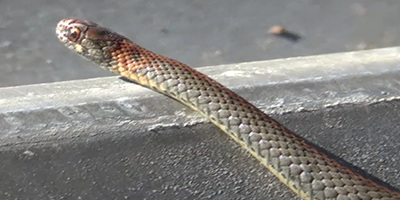 Red-bellied snake:
Red-bellied snakes are surprisingly not always red; they vary in color. The back or red-bellied snakes can come in colors such as red, reddish-brown, or even in darker shades such as tan or black. It has a stripe that uniformly goes down its back, however, it is of a much lighter color as compared to its body color which makes the stripe visible from afar. Their bellies serve justice to their name and stick to either being red or orange. They also have three dots at the base of their neck in either yellow or orange.
Red-bellied snake:
Red-bellied snakes are surprisingly not always red; they vary in color. The back or red-bellied snakes can come in colors such as red, reddish-brown, or even in darker shades such as tan or black. It has a stripe that uniformly goes down its back, however, it is of a much lighter color as compared to its body color which makes the stripe visible from afar. Their bellies serve justice to their name and stick to either being red or orange. They also have three dots at the base of their neck in either yellow or orange.
 Worm snake:
Worm snakes are relatively smaller snakes that have a shiny body. Their shiny body is usually black, brown, or gray and is contrasted by the lighter tones on their belly and this transformation in the color can be observed from the sides as well. Since they are generally small snakes, it comes as no surprise that worm snakes have small eyes along with small, sharp, and pointed heads. Also, as the name suggests, their primary diet consists of earthworms.
Worm snake:
Worm snakes are relatively smaller snakes that have a shiny body. Their shiny body is usually black, brown, or gray and is contrasted by the lighter tones on their belly and this transformation in the color can be observed from the sides as well. Since they are generally small snakes, it comes as no surprise that worm snakes have small eyes along with small, sharp, and pointed heads. Also, as the name suggests, their primary diet consists of earthworms.
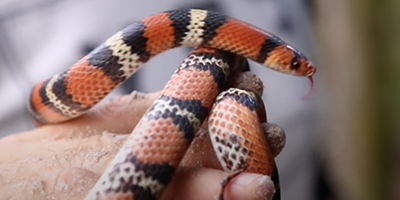 Scarlet snake:
Scarlet snakes are thin and slender snakes that have a smooth body along with smooth scales. Scarlet snakes are often confused with coral snakes due to the resemblance in color combination. Scarlet snakes have bands of either red, yellow, black, or white and can be distinguished from other snakes due to the presence of black bands that acts as a separating line between red and yellow bands on the snake's body. Scarlet snakes have no patterns on their bellies which can be used as another distinguishing physical feature. They have a pointed snout which helps the scarlet snake in burrowing; their main source of food involves reptile eggs which they burrow in the ground for but additionally they also feed on small lizards and sometimes other snakes as well.
Scarlet snake:
Scarlet snakes are thin and slender snakes that have a smooth body along with smooth scales. Scarlet snakes are often confused with coral snakes due to the resemblance in color combination. Scarlet snakes have bands of either red, yellow, black, or white and can be distinguished from other snakes due to the presence of black bands that acts as a separating line between red and yellow bands on the snake's body. Scarlet snakes have no patterns on their bellies which can be used as another distinguishing physical feature. They have a pointed snout which helps the scarlet snake in burrowing; their main source of food involves reptile eggs which they burrow in the ground for but additionally they also feed on small lizards and sometimes other snakes as well.
Venomous Snake Species in Winston Salem
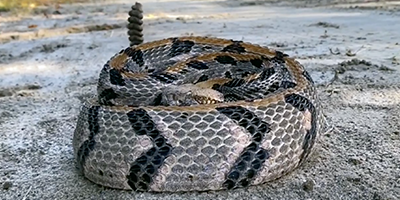 Timber rattlesnake:
The timber rattlesnake is found abundantly throughout the United States. It is famously known as many other names as well such as the American viper, canebrake, and eastern rattlesnake. It is a huge snake of around 2.5-5 feet easily and can grow up to 7 feet. The timber rattlesnake is also a very heavy snake that weighs a lot. Timber rattlesnakes are not fixed to one color but they vary which only adds to their long string of interesting facts. At most times, timber rattlesnakes are grey with shades of pink along with a long and fine stripe going down the same area. The stripe is usually bright which catches the eye immediately such as orange or yellow.
Timber rattlesnake:
The timber rattlesnake is found abundantly throughout the United States. It is famously known as many other names as well such as the American viper, canebrake, and eastern rattlesnake. It is a huge snake of around 2.5-5 feet easily and can grow up to 7 feet. The timber rattlesnake is also a very heavy snake that weighs a lot. Timber rattlesnakes are not fixed to one color but they vary which only adds to their long string of interesting facts. At most times, timber rattlesnakes are grey with shades of pink along with a long and fine stripe going down the same area. The stripe is usually bright which catches the eye immediately such as orange or yellow.
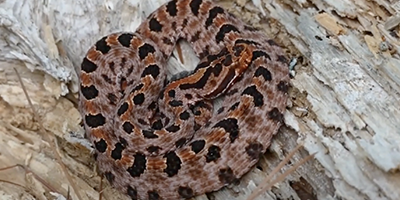 Pygmy rattlesnake:
The pygmy rattlesnake is a rather small animal that only measures around 38 to 56 cm. There are other names for this snake such as ground rattler or pygmy rattler. It is different from other large snakes and has only nine prominent scales on the head along with a rattler which enables it to make a sound. There are three subspecies of pygmy rattlesnakes. The color of the snake along with the spots and patterns on them vary according to the subspecies it belongs to.
Pygmy rattlesnake:
The pygmy rattlesnake is a rather small animal that only measures around 38 to 56 cm. There are other names for this snake such as ground rattler or pygmy rattler. It is different from other large snakes and has only nine prominent scales on the head along with a rattler which enables it to make a sound. There are three subspecies of pygmy rattlesnakes. The color of the snake along with the spots and patterns on them vary according to the subspecies it belongs to.
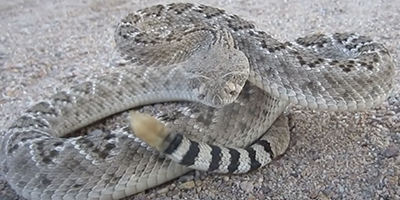 Eastern diamondback:
When we observe North America, the eastern diamondback dominates as the largest poisonous snake in the region. They can grow to be as long as 8 feet and can be as heavy as 4.5 kilograms. Eastern diamondback snakes have a stout body. What makes these snakes stand out is the black diamond-shaped patterns on its body which have yellow borders and are filled with a lighter color in the middle. They usually do not attack humans unless they are provoked or act out as a measure of self-defense.
Eastern diamondback:
When we observe North America, the eastern diamondback dominates as the largest poisonous snake in the region. They can grow to be as long as 8 feet and can be as heavy as 4.5 kilograms. Eastern diamondback snakes have a stout body. What makes these snakes stand out is the black diamond-shaped patterns on its body which have yellow borders and are filled with a lighter color in the middle. They usually do not attack humans unless they are provoked or act out as a measure of self-defense.
If you're unsure, you can email me a photo of the snake at info@winstonsalemsnakes.com and I will email you back with the snake's species. If you found a snake skin, read my Found a Skin? page, and you can email me a photo of the skin, and I'll identify the snake for you. If you need professional Winston Salem snake removal help, click my Get Help page, or see the below website sponsor I found, who provides that service.
A Complete Guide on Diamondback Rattlesnake
Rattlesnakes belong in the group of pit vipers, which are venomous creatures that have heat-sensing organs found between the nostrils and the eyes. The Diamondback rattlesnake can grow up to 3-7 feet and is considered the biggest of the 32 species of rattlesnakes. The longest ever recorded would be 8 feet. The venom of this creature can be fatal to humans.
What is the Appearance of the Diamondback Rattlesnake?
Diamondback Rattlesnake can be muddy gray, blackish-gray, or olive green. The light that has been reflected from the scales of this reptile will make its color appear dull. The tail will generally have a different shade when compared to its body. It may range from gray to brown and will have darker rings. You can easily distinguish this creature through the diamond-shaped symbol on its back. It also features unique dark bands that surround its eyes. and will be outlined by two lighter lines. The pupil is vertical, just like cats. They are bulky snakes; their heads alone can have an average weight of 10lbs.
What is the Habitat of the Diamondback Rattlesnake?
The Diamondback Rattlesnake can be found in different parts of the country. The range of habitat of the Western Diamondback is from the western and central part of Texas to Arizona, the southern section of New Mexico, and the southern part of California. Eastern Diamondback can be found in eastern Louisiana, southern Mississippi, and North Carolina. It also has a thriving population in Florida’s pinelands. When looking for habitat, they prefer to live in pine Flatwoods, barrier islands, coastal forests, and scrublands. They love staying in damp areas like the edge of the wetlands, savannas, and wet prairies. The fields close to the pine forest and abandoned farms are likely to have this vicious animal.
What is the Diet of Diamondback Rattlesnake?
Diamondbacks are not active hunters; they will wait for their prey and ambush them. You can see them patiently waiting near the fallen trees or beside the logs. They will primarily eat birds and small mammals. The young snake will eat mice and rats, and the adult snake will prefer larger prey such as squirrels and rabbits. They will use their heat-sensing pits when looking for prey. Once the victim has been bitten, the snake will immediately release a large venom dose, which makes it one of the deadliest snakes.
How do Diamondback Rattlesnake Reproduce?
The Diamondback Rattlesnake is a solitary animal. During the mating process, the animal will be competing with each other. The male species will raise their bodies and entangle their bodies and try to throw their rivals to the grounds by pushing them. The breeding season will commence in the late period of the summer and the fall season. After 6-7 months, the female snake will give birth to 6-21 baby snakes. The snakes will develop and hatch into the mother’s womb; they will have an average length of 15 inches at the moment they are born. Their patterns and color will already be similar to the adult snake.
Remember, the term is not poisonous snakes of Winston Salem, it's venomous snakes of Winston Salem. Poison is generally something you eat, and venom is injected into you. That said, dangerous snakes are very rare in Winston Salem. The few venomous snakes of Forsynth County are rarely seen. But they are commonly misidentified, so learn about all the snake species of Winston Salem in order to correctly identify them. These snakes are usually also found in the surrounding towns of Winston-Salem, Kernersville, Clemmons, Walkertown, Lewisville, Rural Hall, Pfafftown, Bethania, Tobaccoville, and the surrounding areas.
Read our article about:
I found a snake skin, now what?
winstonsalemsnakes.com domain and hosting costs made possible by the generous support of this sponsor:
